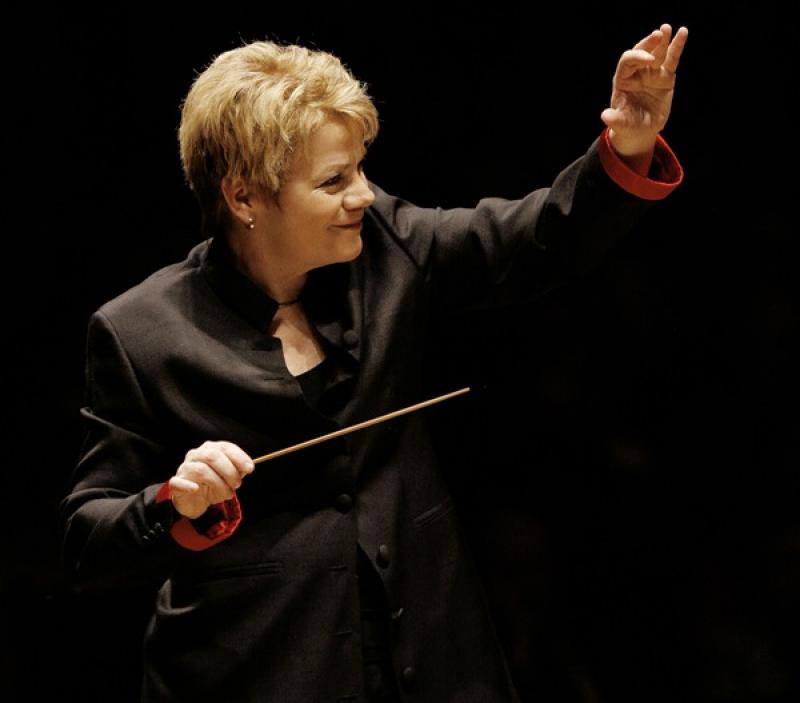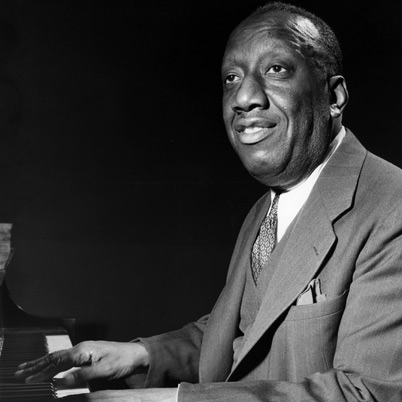The Swingle Singers, São Paulo Symphony Orchestra, Alsop, Royal Festival Hall | reviews, news & interviews
The Swingle Singers, São Paulo Symphony Orchestra, Alsop, Royal Festival Hall
The Swingle Singers, São Paulo Symphony Orchestra, Alsop, Royal Festival Hall
Sixties psychedelia from Berio and masterly Bernstein dances overshadow a Brazilian rarity

Anyone who saw or attended this year’s Last Night of the Proms will know that Marin Alsop is a born communicator with a wry sense of humour. Another of those youthful crowds The Rest is Noise festival keeps attracting gave her a hero’s welcome last night, and she responded with easy compering.
 It certainly had its stretches in the sun. Alsop, the São Paulans and the ever-unique Swingle Singers (seven of last night's eight pictured right by Benedetta Pitscheider) were not to blame if Berio surrounds the most psychedelic of all collages, the Sinfonia’s third and longest movement battening on the rainbow carcase of the scherzo from Mahler’s Second Symphony, with four cloudlets which barely impinge upon the watery-whizzing central landscape.
It certainly had its stretches in the sun. Alsop, the São Paulans and the ever-unique Swingle Singers (seven of last night's eight pictured right by Benedetta Pitscheider) were not to blame if Berio surrounds the most psychedelic of all collages, the Sinfonia’s third and longest movement battening on the rainbow carcase of the scherzo from Mahler’s Second Symphony, with four cloudlets which barely impinge upon the watery-whizzing central landscape.
Maybe, too, I’ve been spoilt by recordings where the balance between amplified voices and orchestra allows every strand, every reference to tell in Berio’s swim through great music from Bach to Berg and Boulez. Here the Swingles were rather more to the fore than is usual, though they timed their spooky harmonies, shouts and speeches to perfection. The absolute star was tenor Oliver Griffiths, who chased streams of consciousness from Beckett’s The Unnamable with necessary histrionics and rounded off with the nameable (his fellow singers and the Maestra).
 Berio’s work homes in on the spirit of ’68 and accommodates a lament for the death of Martin Luther King. Coincidentally, protests over transport in the orchestra's home city turned into violence and destruction on Friday, though there was a more peaceful demonstration in the hall last night. We weren’t at first sure who the singers rising from their seats before the orchestra came on might be, only to acknowledge the resourceful protesters of Shell’s ongoing Southbank concert sponsorship by their death-banner. That’s the way to do it. And it was certainly more fun than Carmargo Guarnieri’s pseudo-tragic string dirge at the heart of his Fourth, Brasilia Symphony of 1963. Lively cross rhythms in the outer movements and brevity were its only virtues, for the invention is unremarkable throughout.
Berio’s work homes in on the spirit of ’68 and accommodates a lament for the death of Martin Luther King. Coincidentally, protests over transport in the orchestra's home city turned into violence and destruction on Friday, though there was a more peaceful demonstration in the hall last night. We weren’t at first sure who the singers rising from their seats before the orchestra came on might be, only to acknowledge the resourceful protesters of Shell’s ongoing Southbank concert sponsorship by their death-banner. That’s the way to do it. And it was certainly more fun than Carmargo Guarnieri’s pseudo-tragic string dirge at the heart of his Fourth, Brasilia Symphony of 1963. Lively cross rhythms in the outer movements and brevity were its only virtues, for the invention is unremarkable throughout.
Never any such problems with Bernstein’s Symphonic Dances from West Side Story, complete with finger-clickings, “Mambo” shouts and that astonishing hover on the brink of atonality in the “Cool” sequence. Despite sterling work throughout the concert by first trumpeter Fernando Dissenha and the trombone department, though, the gym feast never quite swung in the way the Venezuelans can make it, and that was true, too, of the orchestra – though not the Swingles' obbligati – in the riotous encore, Victory Stride by Ragtime pioneer James P Johnson (pictured above). Full credit to Alsop for that, and for a daring programme which still packed ‘em in.
rating
Explore topics
Share this article
The future of Arts Journalism
You can stop theartsdesk.com closing!
We urgently need financing to survive. Our fundraising drive has thus far raised £49,000 but we need to reach £100,000 or we will be forced to close. Please contribute here: https://gofund.me/c3f6033d
And if you can forward this information to anyone who might assist, we’d be grateful.

Subscribe to theartsdesk.com
Thank you for continuing to read our work on theartsdesk.com. For unlimited access to every article in its entirety, including our archive of more than 15,000 pieces, we're asking for £5 per month or £40 per year. We feel it's a very good deal, and hope you do too.
To take a subscription now simply click here.
And if you're looking for that extra gift for a friend or family member, why not treat them to a theartsdesk.com gift subscription?
more Classical music
 Cockerham, Manchester Camerata, Sheen, Martin Harris Centre, Manchester review - re-enacting the dawn of modernism
Two UK premieres added to three miniatures from a seminal event of January 1914
Cockerham, Manchester Camerata, Sheen, Martin Harris Centre, Manchester review - re-enacting the dawn of modernism
Two UK premieres added to three miniatures from a seminal event of January 1914
 Kempf, Brno Philharmonic, Davies, Bridgewater Hall, Manchester review - European tradition meets American jazz
Bouncing Czechs enjoy their Gershwin and Brubeck alongside Janáček and Dvořák
Kempf, Brno Philharmonic, Davies, Bridgewater Hall, Manchester review - European tradition meets American jazz
Bouncing Czechs enjoy their Gershwin and Brubeck alongside Janáček and Dvořák
 Solomon, OAE, Butt, QEH review - daft Biblical whitewashing with great choruses
Even a top soprano and mezzo can’t make this Handel paean wholly convincing
Solomon, OAE, Butt, QEH review - daft Biblical whitewashing with great choruses
Even a top soprano and mezzo can’t make this Handel paean wholly convincing
 Two-Piano Gala, Kings Place review - shining constellations
London Piano Festival curators and illustrious friends entertain and enlighten
Two-Piano Gala, Kings Place review - shining constellations
London Piano Festival curators and illustrious friends entertain and enlighten
 Echo Vocal Ensemble, Latto, Union Chapel review - eclectic choral programme garlanded with dance
Beautiful singing at the heart of an imaginative and stylistically varied concert
Echo Vocal Ensemble, Latto, Union Chapel review - eclectic choral programme garlanded with dance
Beautiful singing at the heart of an imaginative and stylistically varied concert
 Scott, Irish Baroque Orchestra, Whelan, RIAM, Dublin review - towards a Mozart masterpiece
Characteristic joy and enlightenment from this team, but a valveless horn brings problems
Scott, Irish Baroque Orchestra, Whelan, RIAM, Dublin review - towards a Mozart masterpiece
Characteristic joy and enlightenment from this team, but a valveless horn brings problems
 Classical CDs: Voice flutes, flugelhorns and froth
Baroque sonatas, English orchestral music and an emotionally-charged vocal recital
Classical CDs: Voice flutes, flugelhorns and froth
Baroque sonatas, English orchestral music and an emotionally-charged vocal recital
 Kanneh-Mason, Britten Sinfonia, Shave, Milton Court - a grin and a big beaming smile
A pair of striking contemporary pieces alongside two old favourites
Kanneh-Mason, Britten Sinfonia, Shave, Milton Court - a grin and a big beaming smile
A pair of striking contemporary pieces alongside two old favourites
 theartsdesk at the New Ross Piano Festival - Finghin Collins’ musical rainbow
From revelatory Bach played with astounding maturity by a 22 year old to four-hand jazz
theartsdesk at the New Ross Piano Festival - Finghin Collins’ musical rainbow
From revelatory Bach played with astounding maturity by a 22 year old to four-hand jazz
 First Person: Manchester Camerata's Head of Artistic Planning Clara Marshall Cawley on questioning the status quo
Five days of free events with all sorts of audiences around Manchester starts tomorrow
First Person: Manchester Camerata's Head of Artistic Planning Clara Marshall Cawley on questioning the status quo
Five days of free events with all sorts of audiences around Manchester starts tomorrow

Add comment